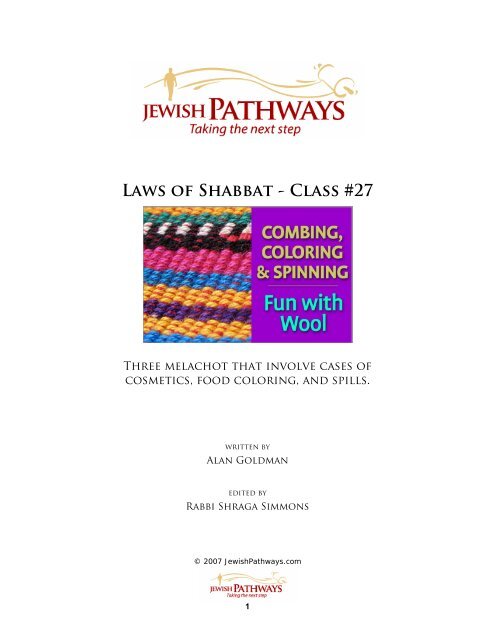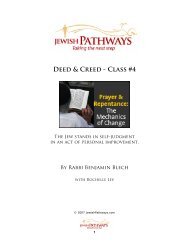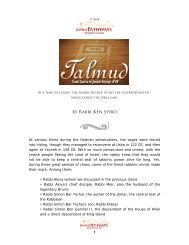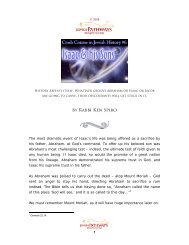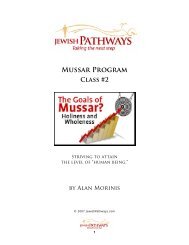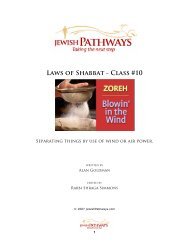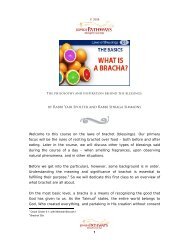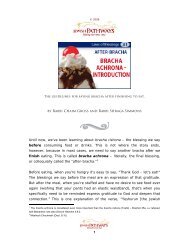Laws of Shabbat - Class #27 - JewishPathways.com
Laws of Shabbat - Class #27 - JewishPathways.com
Laws of Shabbat - Class #27 - JewishPathways.com
Create successful ePaper yourself
Turn your PDF publications into a flip-book with our unique Google optimized e-Paper software.
<strong>Laws</strong> <strong>of</strong> <strong>Shabbat</strong> - <strong>Class</strong> <strong>#27</strong><br />
Three melachot that involve cases <strong>of</strong><br />
cosmetics, food coloring, and spills.<br />
written by<br />
Alan Goldman<br />
edited by<br />
Rabbi Shraga Simmons<br />
© 2007 <strong>JewishPathways</strong>.<strong>com</strong><br />
1
Combing - Menapetz<br />
We now continue with processing the wool we’ve just cleaned. Our<br />
next job is to arrange it so that the fibers be<strong>com</strong>e smoother and<br />
straighter. This activity is known as Menapetz, 1 and may be done by<br />
beating the wool, picking through it, or <strong>com</strong>bing it. Since this last<br />
method is the most effective and <strong>com</strong>mon, we use it to define this<br />
melacha.<br />
There are only a few applications <strong>of</strong> Menapetz.<br />
Combing a wig – A sheitel is the traditional name for the wig that<br />
many observant women use to cover their own hair. They may be<br />
made <strong>of</strong> human hair, synthetic hair, or a <strong>com</strong>bination. Combing the<br />
sheitel so that the hairs are in place is considered an act <strong>of</strong> Menapetz<br />
according to some opinions. 2 To avoid this issue, a woman may use a<br />
s<strong>of</strong>t-bristle brush or wide-toothed <strong>com</strong>b that will improve the sheitel’s<br />
appearance, but will not closely align the fibers. 3<br />
Untangling tzitzit – Let’s move over to the<br />
men’s side now. Tzitzit, the fringes that many<br />
observant men wear, are made <strong>of</strong> tightly tied<br />
wool, and attached to a light garment that is<br />
worn underneath a man’s shirt. If the tzitzit<br />
fringes be<strong>com</strong>e tangled, a person is not<br />
allowed to disentangle them on <strong>Shabbat</strong>, since<br />
this closely resembles <strong>com</strong>bing out wool. 4<br />
1 Pronounced meh-nah-PAITS.<br />
2 They reason that, since Menapetz involves “creating usable fibers from… tangled fibers”<br />
(Principles <strong>of</strong> Hilchos Shabbos, ‘Menapetz’), this action is no different. Orach Chaim 337:2; 39<br />
Melochos, p. 735.<br />
3 Shemirat <strong>Shabbat</strong> K’Hilchato 14:46; 39 Melochos, p. 735.<br />
4 Principles <strong>of</strong> Hilchos Shabbos, ‘Menapetz’.<br />
2
Coloring - Tzovaya<br />
In the Mishkan, three specific colors <strong>of</strong> wool – scarlet, blue and purple<br />
– were required, 5 so it was necessary to dye the wool once it had been<br />
cleaned and <strong>com</strong>bed.<br />
This melacha, called Tzovaya, 6 is actually very relevant today. Tzovaya<br />
may be defined as “creating a more suitable object by changing or<br />
strengthening its color.” 7 This melacha is a good illustration <strong>of</strong> a basic<br />
principle underlying the laws <strong>of</strong> <strong>Shabbat</strong>: ‘creative labor’ is forbidden,<br />
regardless <strong>of</strong> the amount <strong>of</strong> effort it takes.<br />
Now, in order to be considered Tzovaya under Torah law, the action<br />
has to result in a “lasting” form <strong>of</strong> coloring. That is, the coloring needs<br />
to remain in place for at least a short period <strong>of</strong> time. This is because<br />
the classic case <strong>of</strong> Tzovaya is dyeing fabric, which is actually a<br />
permanent form <strong>of</strong> coloring. However, even coloring that lasts only<br />
briefly is considered to be Tzovaya under rabbinic law. 8<br />
In practice, then, there are only a few examples <strong>of</strong> coloring that is so<br />
temporary that it is permitted on <strong>Shabbat</strong>. One <strong>of</strong> these is photo-gray<br />
lenses (the kind that darken automatically in sunlight and then fade to<br />
normal indoors). 9<br />
What Actions Involve Coloring?<br />
What <strong>com</strong>es to mind when we think <strong>of</strong> “coloring”? There are some<br />
obvious examples, such as painting your house (or anything else) and<br />
drawing a picture. 10 (And these activities are, indeed, not allowed on<br />
<strong>Shabbat</strong>.)<br />
5 See Exodus 25:4.<br />
6 Pronounced tsoh-VAY-ah.<br />
7 Principles <strong>of</strong> Hilchos Shabbos, ‘Tzoveyah’.<br />
8 Rambam (<strong>Shabbat</strong> 9:13)<br />
9 Shu”t Igros Moshe (Orach Chaim 3:45); Shemirat <strong>Shabbat</strong> K’Hilchato 18:70; 39 Melochos, p. 748.<br />
There is room to suggest that there is no coloring <strong>of</strong> the lens at all, but is rather like pulling down a<br />
shade. Also, nothing is done by the person to effect the color change.<br />
10 Drawing a picture is also a problem <strong>of</strong> Kotaiv (writing), a melacha we’ll learn about soon.<br />
3
Cosmetics<br />
An important, and <strong>com</strong>mon, application <strong>of</strong> Tzovaya is putting on<br />
cosmetics. Almost all types <strong>of</strong> makeup – including blush, lipstick, eye<br />
shadow, nail polish, and so on – are intended to add color to a<br />
person’s body. As a general rule, then, putting on makeup during<br />
<strong>Shabbat</strong> is not allowed. 11<br />
This halacha probably <strong>com</strong>es as a surprise to<br />
many readers. Indeed, many observant<br />
women do not use makeup on <strong>Shabbat</strong>.<br />
Nevertheless, a couple <strong>of</strong> qualifications are in<br />
order:<br />
• Makeup can be put on prior to <strong>Shabbat</strong> and<br />
left on until <strong>Shabbat</strong> ends.<br />
• The melacha <strong>of</strong> Tzovaya only applies when<br />
the coloring is actually attached to the<br />
material being colored. Because <strong>of</strong> this, some opinions do permit the<br />
use <strong>of</strong> makeup that does not ‘attach’ – i.e. it is (a) non-oil-based and<br />
(b) in the form <strong>of</strong> powder. 12<br />
In fact, there are cosmetic products on the market that are advertised<br />
as acceptable for use on <strong>Shabbat</strong>. If this sounds tentative, it is – this is<br />
a <strong>com</strong>plex area <strong>of</strong> halacha, and each product should be researched<br />
before being used. 13<br />
Finally, it is permitted on <strong>Shabbat</strong> to ‘remove color’ – e.g. by washing<br />
makeup <strong>of</strong>f one’s face. 14<br />
11 Using makeup is also a problem <strong>of</strong> Memaraich (smoothing), a melacha we’ll learn about soon.<br />
12 Principles <strong>of</strong> Hilchos Shabbos, ‘Tzoveyah’.<br />
13 For those who want to read further, there is a thorough and clearly-written set <strong>of</strong> three articles<br />
about the use <strong>of</strong> makeup on <strong>Shabbat</strong> by Rabbi Chaim Jachter. They are available at<br />
www.koltorah.org/rabbij.<br />
14 Shemirat <strong>Shabbat</strong> K’Hilchato 14:79<br />
4
Food<br />
Perhaps the most <strong>com</strong>mon kind <strong>of</strong> “coloring” we do takes place in the<br />
kitchen. Whenever we <strong>com</strong>bine foods, the colors mix with each other.<br />
This would seem to be a major issue, but actually there is a principle<br />
in halacha <strong>of</strong> Ain Tzovaya B’ochlin – “there is no (prohibition <strong>of</strong>)<br />
coloring regarding foods.” Why? Because food is meant to be<br />
consumed, and so is different from dyed wool or other items that we<br />
color and keep for ongoing use. 15<br />
What this principle means is: If you<br />
add an ingredient to food to make it<br />
taste better, the fact that the food’s<br />
color will change is not a problem. 16<br />
Similarly, if you have two foods next<br />
to each other on your plate – a good<br />
example would be turkey and<br />
cranberry sauce – the fact that the<br />
color <strong>of</strong> one will rub <strong>of</strong>f on the other<br />
is also fine.<br />
This principle does not include coloring food merely for decoration. So<br />
adding food coloring which adds no taste and only makes the food look<br />
better is an act <strong>of</strong> Tzovaya and is therefore not allowed. 17<br />
Wiping Spills<br />
Finally, there is the issue <strong>of</strong> coloring that actually makes something<br />
look worse. The classic example is wiping up a dark spill (e.g., wine)<br />
with a clean white cloth. To be sure, the cloth gets colored, but not in<br />
15 Orach Chaim 320:19; 39 Melochos, p. 750-51.<br />
16 Some authorities prefer that you add the ‘coloring’ ingredient first, and then add the item that will<br />
be colored. For example, if you’re making chocolate milk by adding syrup to the milk, put the syrup<br />
in first and then add the milk. In this way, the coloring is ac<strong>com</strong>plished less directly. Sha’ar<br />
HaTziyun 318:65; 39 Melochos, p. 751.<br />
17 Mishnah Berurah 320:56<br />
5
a way that a person wants. As a result, many authorities say that this<br />
kind <strong>of</strong> coloring is permitted on <strong>Shabbat</strong>. 18<br />
Other authorities don’t like this exception. They re<strong>com</strong>mend that we<br />
should wipe colored stains with a cloth that is (1) not white and (2)<br />
not the same color as the stain. 19<br />
Disposable cloths (such as napkins and paper towels) can be used<br />
according to everyone. There’s no issue <strong>of</strong> improving their appearance<br />
since they are thrown out right away. 20<br />
(It is important to take care in handling a paper towel that is fully<br />
saturated, as moving it will inevitably cause liquid to be squeezed out,<br />
which is a prohibition <strong>of</strong> sechitah – see Lesson #9.) 21<br />
Spinning - Toveh<br />
Once the wool was dyed in the<br />
Tabernacle, it needed to be spun into a<br />
form that could be used to create fabric.<br />
Such spinning is known as Toveh, 22 and<br />
was ac<strong>com</strong>plished by twisting the<br />
individual strands <strong>of</strong> wool into a stronger,<br />
“continuous thread.” 23<br />
The idea behind Toveh has little<br />
application outside <strong>of</strong> spinning thread or<br />
some other fiber (for example, twisting cotton to form a wick). 24 These<br />
would be prohibited whether the spinning is done by hand or using a<br />
spinning wheel.<br />
18 Mishnah Berurah 320:59; 39 Melochos, p. 753-54.<br />
19 Principles <strong>of</strong> Hilchos Shabbos, ‘Tzoveyah’. White is not re<strong>com</strong>mended because any color will<br />
show up on it, and using the same color as the stain is not re<strong>com</strong>mended because the stain acts to<br />
deepen the color <strong>of</strong> the fabric.<br />
20 Mishnah Berurah 302:57; 39 Melochos, p. 755.<br />
21 As discussed there, some opinions are lenient regarding paper towels.<br />
22 Pronounced toe-VEH.<br />
23 Mishnah Berurah, appendix to Orach Chaim 344; 39 Melochos, p. 757.<br />
24 Sha’ar HaTziyun 514:52; 39 Melochos, p. 758.<br />
6


